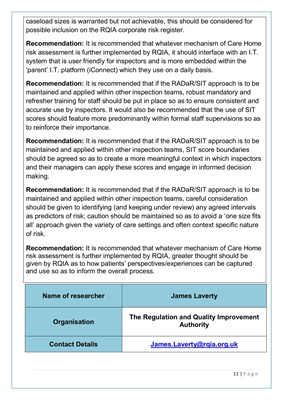
11 | P a g e
caseload sizes is warranted but not achievable, this should be considered for
possible inclusion on the RQIA corporate risk register.
Recommendation: It is recommended that whatever mechanism of Care Home
risk assessment is further implemented by RQIA, it should interface with an I.T.
system that is user friendly for inspectors and is more embedded within the
'parent' I.T. platform (iConnect) which they use on a daily basis.
Recommendation: It is recommended that if the RADaR/SIT approach is to be
maintained and applied within other inspection teams, robust mandatory and
refresher training for staff should be put in place so as to ensure consistent and
accurate use by inspectors. It would also be recommended that the use of SIT
scores should feature more predominantly within formal staff supervisions so as
to reinforce their importance.
Recommendation: It is recommended that if the RADaR/SIT approach is to be
maintained and applied within other inspection teams, SIT score boundaries
should be agreed so as to create a more meaningful context in which inspectors
and their managers can apply these scores and engage in informed decision
making.
Recommendation: It is recommended that if the RADaR/SIT approach is to be
maintained and applied within other inspection teams, careful consideration
should be given to identifying (and keeping under review) any agreed intervals
as predictors of risk; caution should be maintained so as to avoid a 'one size fits
all' approach given the variety of care settings and often context specific nature
of risk.
Recommendation: It is recommended that whatever mechanism of Care Home
risk assessment is further implemented by RQIA, greater thought should be
given by RQIA as to how patients' perspectives/experiences can be captured
and use so as to inform the overall process.
Name of researcher
James Laverty
Organisation
The Regulation and Quality Improvement
Authority
Contact Details james.laverty@rqia.org.uk